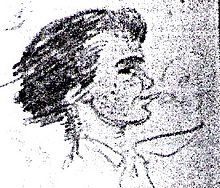Bernhard Studer (painter)
Bernhard Studer (born August 5, 1832 in Gunzgen , Canton Solothurn , Switzerland ; † April 22, 1868 in Munich ) was a Swiss landscape painter .
Life
Studer grew up as the son of the flat painter Leonz Studer, initially in Gunzgen (Canton Solothurn). At the age of 14 he began an apprenticeship in drawing with the sculptor Johann Georg Lüthy in Olten . He then attended the drawing school in Solothurn, where he took part in lessons from Gaudenz Taverna . On the advice of his teachers, Bernhard Studer was finally sent to the art academy in Munich in 1850 . Here he also found work in the workshop of the landscape painter Karl Millner (1825–1895). But Studer moved back to his home country after less than two years. Mainly financial reasons were the decisive factors.
With the support of the cantonal government of Solothurn, which granted him a student loan, Studer was able to begin studying at the Düsseldorf Art Academy in 1853 , the center of the Düsseldorf School of Painting , where he studied landscape painting with Rudolf Wiegmann , Johann Wilhelm Schirmer and Hans Gude . After initially performing very well, however, he was dismissed from the academy in the first quarter of 1856 "because of a messy life". During his years in Düsseldorf, Studer was also a frequent guest at the Malkasten artists' association .
In the same year Studer followed his teacher Schirmer to Karlsruhe at the art academy there . During this time he regularly sent the rotating exhibitions of the Swiss Art Association in Bern . In 1857 he received the silver medal for his painting A Region in the Jura . In Karlsruhe and Baden-Baden , too , he repeatedly took part in group exhibitions. He had closer contacts a. to his artist colleagues Hans Thoma and Eugen Bracht .
Bernhard Studer found literary mention in the biographical novel "Hans Marbot". This book describes the career of the architect Friedrich Baumann , with whom Studer had a deep friendship. The only known portrait painting that can be traced back to Bernhard Studer has also survived from the time in Karlsruhe.
After a few years in Karlsruhe, Studer finally moved to Munich in 1865, where he died on April 22, 1868.
plant
Studer mainly dealt with motifs from his Swiss homeland, more precisely the Gäu , an area between Solothurn and Olten at the southern foot of the Jura . Are known z. B. two paintings by Neu-Bechburg Castle , one of them and probably his best and largest work can be viewed at this castle. In addition, he has also devoted himself to depicting other alpine landscapes (including the high Göll , Mondschein am Walensee ). Characteristic for Studer are his quiet, almost poetic depictions of alpine nature and its people. A small number of soulful images that deal with village and farm scenes have also been preserved. Some of the pictures are in the art museums of Olten and Solothurn (Switzerland). Many works are likely to be in private hands. An initiative in Switzerland is trying to compile a catalog raisonné of this artist.
swell
- Archive artist association Malkasten Düsseldorf
- Archive Art Academy Düsseldorf
- Archive Academy of Fine Arts Munich
- Kunstmuseum Olten (Switzerland)
- Art Museum Solothurn (Switzerland)
- Munich City Archives
- Archives of the Archdiocese of Munich and Freising
literature
- Anna Katharina Bähler : Bernhard Studer. In: Historical Lexicon of Switzerland . 3rd July 2012 .
- H. Appenzeller: Studer, Bernhard . In: Carl Brun (Ed.): Swiss Artist Lexicon . Volume 3: S-Z. Huber & Co., Frauenfeld 1913, p. 271 ( Textarchiv - Internet Archive ).
- Paul Ganz : Yearbook for Art and Art Care in Switzerland, 1915–1921. Basel 1923.
- Alexander Koch (Hrsg.): German art and decoration. Issue 2, Darmstadt 1925.
- Studer, Bernhard . In: Hans Vollmer (Hrsg.): General lexicon of fine artists from antiquity to the present . Founded by Ulrich Thieme and Felix Becker . tape 32 : Stephens – Theodotos . EA Seemann, Leipzig 1938, p. 234 .
- Jules Pfluger: Bernhard Studer the forgotten painter from Gunzgen. In: Oltner Neujahrsblätter . Volume 41, 1983, pp. 51-53 ( e-periodica.ch ).
- Hans A. Sigrist: Hägendorfer Jahrringe 2006. Issue 5, Olten 2006.
- Harold Baumann (Ed.): Erwin Friedrich Baumann: Hans Marbot. Norderstedt 2008.
- Markus Husy, Dieter Albert: Bernhard Studer (1832–1868). The "almost" forgotten painter from Gunzgen. In: Yearbook for Solothurn History. 80/2007, pp. 311-331, doi: 10.5169 / seals-325253 .
Web links
- Studer, Bernhard. In: Sikart
- 00831 Bernhard Studer matrikel.adbk.de
- Detailed biography and preliminary catalog raisonné on «as nüüt eso» (Markus Husy)
Individual evidence
- ^ Academy of Fine Arts in Munich (ed.): Matriculation book. Volume 2: 1841–1884 ( Digitale-sammlungen.de ).
| personal data | |
|---|---|
| SURNAME | Studer, Bernhard |
| BRIEF DESCRIPTION | Swiss landscape painter |
| DATE OF BIRTH | August 5, 1832 |
| PLACE OF BIRTH | Gunzgen , Canton of Solothurn , Switzerland |
| DATE OF DEATH | April 22, 1868 |
| Place of death | Munich |



